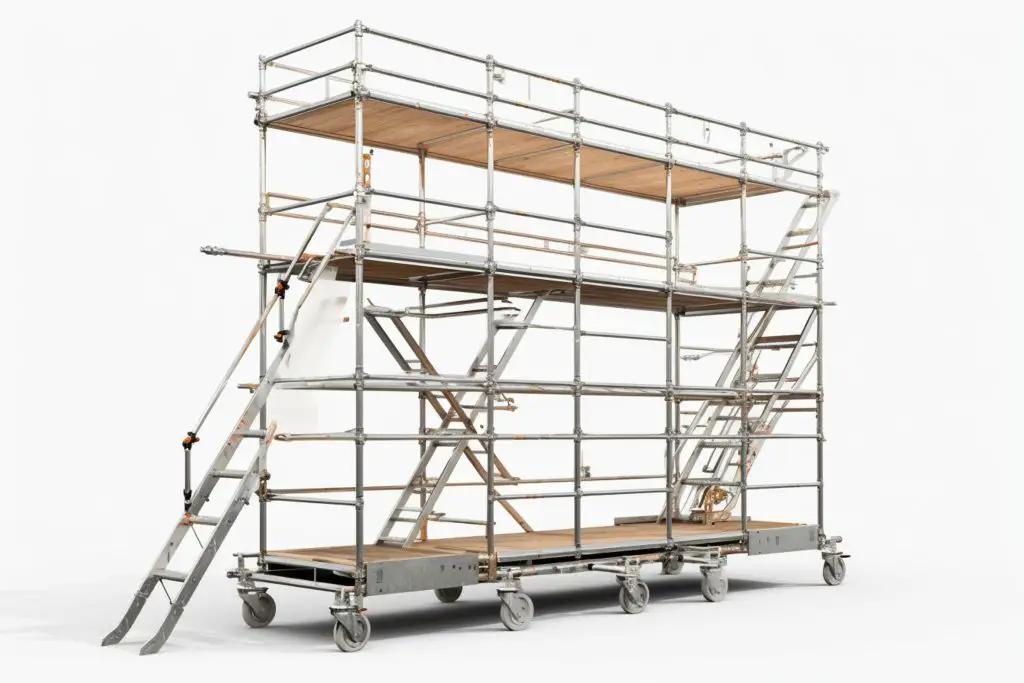In construction, safety and efficiency are closely intertwined. Investing in safety equipment ensures the protection of every worker on site and also streamlines operations, enhancing overall efficiency. One such piece of safety equipment is mobile scaffolding.

Often referred to as ‘rolling’ or ‘movable’ scaffolding, this type is mounted on casters or wheels. This design allows for easy movement across a site, making it particularly useful for tasks that require frequent changes in position. There are many benefits to this type of scaffolding. But first, the different types.
Types Of Mobile Scaffolding
Here are some of the common types:
- Single-width mobile scaffolds: These are narrow and designed for tasks in confined spaces, such as hallways or narrow aisles. They are ideal for indoor tasks where space is limited.
- Double-width mobile scaffolds: These are wider and can accommodate more workers or materials. They are suitable for tasks that require more space, such as painting or window cleaning.
- Folding scaffolds: These are designed for quick assembly and disassembly. They are ideal for short-term tasks or projects that require frequent relocation.
- Tower scaffolds: These are tall mobile scaffolds designed for working at significant heights. They come with multiple levels and can be extended vertically.
Each type of mobile scaffolding is designed with specific tasks in mind, so it’s essential to choose the right one based on the job’s requirements.
Why Mobile Scaffolding Is A Worthy Investment?
Imagine you’re painting the exterior of a two-story house. Traditional scaffolding would require a fixed structure, taking time to set up and limiting your movement.
Mobile scaffolding, on the other hand, is a free-standing structure with wheels. This means you can easily move it around, adjusting to different parts of the house without the need for disassembly and reassembly.
Key Benefits Of Mobile Scaffolding
Here are the benefits of mobility:
- Safety first: Mobile scaffolding is designed with worker safety in mind. The guardrails and locking wheels ensure that they remain stable and secure, even when working at considerable heights.
- Flexibility in motion: Picture this: you’re working on a renovation project that spans multiple rooms. With mobile scaffolding, you can easily transition from one room to another.
- Boosted efficiency: Time is money. Mobile scaffolding reduces the time spent on setup and dismantling. Plus, it allows multiple workers to operate simultaneously, speeding up project completion.
- Space-saver: For those tight projects where space is at a premium, mobile scaffolding’s compact design is a boon. It’s easy to store and perfect for confined areas.
- Cost-effective in the long run: While the initial investment might seem steep, think of the long-term savings. The durability means fewer replacements, and the reduced labor costs due to increased efficiency add up over time.
These benefits highlight mobile scaffolding as an essential tool in your construction projects. But to reap these good fruits, you must choose only the best.
Choosing The Right Mobile Scaffolding For Your Needs
Selecting the appropriate mobile scaffolding is crucial to ensure both safety and efficiency. Here are some key considerations to keep in mind:
- Material: Aluminum is lightweight, resistant to corrosion, and easy to move. On the other hand, steel is heavier, more durable, and ideal for larger projects.
- Height and size: While larger platforms can accommodate more workers, they might be less maneuverable in tight spaces.
- Load capacity: The scaffolding must be able to support the weight of workers, tools, and materials. Always adhere to the manufacturer’s weight limits to ensure safety.
- Wheel quality: Opt for scaffolding with locking mechanisms on the wheels to ensure stability.
- Safety features: Guardrails are a must, especially for higher platforms. Additionally, non-slip platforms and toe boards can prevent tools and materials from falling off.
- Ease of assembly: Some scaffolding models are more user-friendly and can be set up quickly. Those with color-coded components or clear instructions can save valuable time during assembly.
When choosing mobile scaffolding, always prioritize safety and functionality. By taking into account the above factors, you can select scaffolding that perfectly aligns with your project’s specific needs and ensures the safety of all workers involved.
In Closing
Whether you’re a homeowner looking to undertake a DIY project or a business aiming for minimal disruption during renovations, mobile scaffolding is an investment that promises substantial returns.



